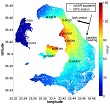The Santorini caldera has been a source of numerous eruptions and tsunamis in the past with the most recent seismic sequence ending in 1950 .Since then, Santorini volcano was in a "quiet" phase, with insignificant deformation and limited seismic activity.
The Santorini caldera has been a source of numerous eruptions and tsunamis in the past with the most recent seismic sequence ending in 1950 .Since then, Santorini volcano was in a "quiet" phase, with insignificant deformation and limited seismic activity.
In this study the team present and discuss the surface deformation associated to the intense geophysical activity recently occurred at the Santorini volcano. Envisat ASAR time series have been used to perform an InSAR analysis during the period of unrest, spanning from January 2011 to February 2012, with two well established techniques, namely, Persistent Scatterer Interferometry (PSI) and Small Baseline Subset (SBAS), producing dense line of sight (LOS) ground deformation maps. The displacement field was compared with GPS observations from 10 permanent sites installed on Santorini. Results show a clear and large inflation signal, rising up to 150mm/yr in the LOS direction, with a radial pattern outward from the center of the caldera. Inversion of the InSAR and GPS data using a Mogi model suggests a source located north of the Nea Kameni island, at a depth between 3.3km and 6.3km and with a volume change rate in the range of 12 million m3 to 24 million m3 per year.
